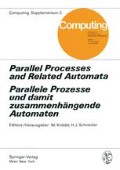Abstract
A Program System of Parallel Processes for Understanding Continuous Speech. A system concept is shown which enables several independent processes, each having specialized knowledge about one aspect of a complex real world pattern, to cooperate in parallel, analyzing and understanding this pattern automatically.
A software environment is introdueed, providing an experimenter with tools to define different system configurations and to develop reasonable control strategies for them.
Intended is a usage for the automatic understanding of continuously spoken german sentences. The principles of the various knowledge modules which will be needed for this pattern analysis task are given also.
Zusammenfassung
Ein Programmsystem von parallelen Prozessen zum Verständnis kontinuierlicher Sprache. Es wird ein Systemkonzept vorgestellt, bei dem mehrere unabhängige Prozesse parallel zusammenarbeiten können, um ein komplexes Muster der realen Welt automatisch zu analysieren und zu verstehen. Jeder Prozeß besitzt dazu spezielles Wissen über einen Aspekt des Musters.
Die Softwareumgebung, die es einem Experimentator erlaubt, unterschiedliche Konfigurationen festzulegen und geeignete Kontrollstrategien für diese zu entwickeln, wird beschrieben.
Da eine Verwendung für das automatische Verstehen fließend gesprochener deutscher Sätze vorgesehen ist, werden die Prinzipien der verschiedenen Wissensmodule, die man bei diesem Problem der Musteranalyse benötigt, ebenfalls dargelegt.
Access this chapter
Tax calculation will be finalised at checkout
Purchases are for personal use only
Preview
Unable to display preview. Download preview PDF.
References
Chapanis, A.: Interactive human communication. Scient. American 232, 36–42 (1975).
De Mori, R.: Recent advances in automatic speech recognition. Proc. 4. J. Conf. on Pattern Recognition, Kyoto, Japan, pp. 106–124 (1978).
Ainsworth, W. A., Green, P. D.: Current problems in automatic speech recognition. In: Pattern recognition: Ideas in practice (Batchelor, B. G., ed.), pp. 365–396. New York: Plenum Press 1978.
Bates, M.: The theory and practice of augmented transition network (ATN) grammars. In: Natural language communication with Computers (Lecture Notes in Computer Science, Vol. 63), (Goos, G., Hartmanis, J., ed.), pp. 191–259. Berlin-Heidelberg-New York: Springer 1978.
Walker, D. E. (ed.): Understanding spoken language. New York: North-Holland 1978.
Fennell, R. D., Lesser, V. R.: Parallelism in artificial intelligence problem solving: A case study of HEARSAY-II. IEEE Transactions C-26, 98–111 (1977).
Klatt, D. H.: Review of the ARPA speech understanding project. J. Acoust. Soc. Am. 62, 1345–1366 (1977)
Niemann, H.: Digital image analysis. In: Recent advances in digital image processing (Stucki, P., ed.), pp. 77–122. New York: Plenum Press 1979.
Woods, W. A.: Shortfall and density scoring strategies for speech understanding control, Report No. 3303. Cambridge: Bolt Beranek & Newman Inc. 1976.
Date, C. J.: An introduction to database systems, 2nd ed. Reading, Mass.: Addison-Wesley 1977.
Schafer, R. W., Rabiner, L. R.: Parametric representations of speech. In: Speech recognition (Reddy, D. R., ed.), pp. 99–150. New York: Academic Press 1975.
Makhoul, J.: Linear prediction in automatic speech recognition. In: Speech recognition (Reddy, D. R., ed.), pp. 183–220. New York: Academic Press 1975.
Forney, G. D.: The Viterbi algorithm. Proc. IEEE 61268–278 (1973).
Bobrow, D. G., et al.: GUS, a frame-driven dialog system. Artificial Intelligence 8, 155–173 (1977).
Author information
Authors and Affiliations
Editor information
Editors and Affiliations
Rights and permissions
Copyright information
© 1981 Springer-Verlag
About this chapter
Cite this chapter
Niemann, H., Hein, HW. (1981). A Program System of Parallel Processes for Understanding Continuous Speech. In: Knödel, W., Schneider, H.J. (eds) Parallel Processes and Related Automata / Parallele Prozesse und damit zusammenhängende Automaten. Computing Supplementum, vol 3. Springer, Vienna. https://doi.org/10.1007/978-3-7091-8596-4_9
Download citation
DOI: https://doi.org/10.1007/978-3-7091-8596-4_9
Publisher Name: Springer, Vienna
Print ISBN: 978-3-211-81606-6
Online ISBN: 978-3-7091-8596-4
eBook Packages: Springer Book Archive

